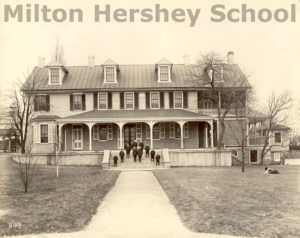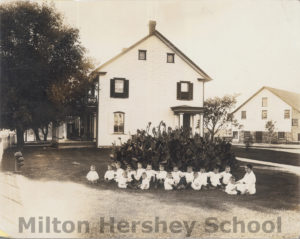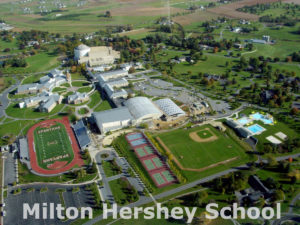History of Milton Hershey School

Milton Hershey School began as a vision shared by chocolate entrepreneur Milton S. Hershey and his wife, Catherine (Kitty). The Hersheys loved children but were unable to have their own. Instead, they decided to use their wealth to create a home and school for children in need.
On November 15, 1909, Milton and Catherine Hershey signed the Deed of Trust establishing what was then known as the Hershey Industrial School. Healthy orphan boys whose fathers had passed away between the ages of four and eight were to be admitted.
Milton Hershey’s own experiences as a child growing up in an unstable family environment and Catherine’s involvement in a philanthropic organization that helped families undoubtedly influenced their decision. When pressed by others for an explanation, Milton Hershey would matter-of-factly state, “It was Kitty’s idea.” When asked why he started the school, he replied, “I was successful in business because I had opportunities. When the opportunities came I took them. I want to make these boys who started poor have opportunities too.”
The Hershey’s goal was to create a home and school to give children a stable home life, a sound education, and vocational training. The Deed of Trust covered how each boy was to be cared for.
All orphans admitted to the School shall be fed with plain, wholesome food; plainly, neatly, and comfortably clothes, without distinctive dress, and fitly lodged. Due regard shall be paid to their health; their physical training shall be attended to, and they shall have suitable and proper exercise and recreation.
Remembering the happy hours he had spent growing up in the country, Milton felt it important that the students learned about agriculture, horticulture, and gardening as well as caring for animals. No fixed course was assigned, but the objective was to teach the students a trade so they would leave the school and make their way in the world as useful citizens.
The first four students, two sets of brothers, enrolled on September 3, 1910. They lived and had a classroom in Milton Hershey’s birthplace and family farm, the Homestead. Superintendent George Copenhaver and his wife, Prudence, college-educated teachers, taught and cared for the children.
As the school grew, students lived in homes Milton Hershey owned. The first, Kinderhaus, housed the youngest children. It is now the MHS Heritage Center and houses the school archives.

Sadly, Catherine Hershey passed away on March 25, 1915. That event, World War I, and a sugar crisis prompted Milton Hershey to place almost his entire fortune in a perpetual trust for the security of the school on November 13, 1918. News about the amazing gift did not become public until 1923. In an article in Fortune magazine in 1924, Milton Hershey explained why he gave his money away. “I never could see what happiness a rich man gets from contemplating a life of acquisition only, with the cold and legal distribution of his money after he is gone. For myself, would I find any further zest in accumulating wealth? No, but now I am more interested than ever in maintaining and improving the morale and efficiency of all my companies. I want to devote the rest of my life to that end, for the school.”
In the 1920s, with enrollment over 100 students, new buildings were erected. Milton and Catherine Hershey felt strongly that the school was a home and school and not an institution. The first new homes built were called cottage homes, large brick buildings with a gymnasium in the basement. At Milton Hershey’s insistence, beginning in 1929, students in grades six through twelve lived on farms, doing the field and dairy work.
In 1933, reflecting challenging times in the nation, Milton Hershey changed the enrollment requirements in the Deed of Trust, increasing the age to four through 14 and either mother or father be deceased. On November 15, 1934, the 25th anniversary of the founding of the school, the new Hershey Industrial School Junior-Senior High School (current Catherine Hall middle school) was dedicated. The state-of-the-art building, set on Pat’s Hill above the town, featured classrooms for grades six through twelve and eight vocational shops.

The advent of World War II brought similar changes to the school as the rest of the country. The sheet metal and auto mechanic shops were changed to aircraft repair training. Many young alumni served in the war, over 1,000 by the war’s end, and 39 of those lost their lives. Those alumni and other Gold Star Alumni are honored every year at a special Memorial Day Assembly, as are Milton and Catherine Hershey. Milton Hershey’s death on October 13, 1945, cast a pall over the school and community.
The name of the school was changed in 1951 to better reflect that the school was an excellent academic and vocational school. In 1959, the school celebrated the 50th anniversary and made plans for the next decade. The 1960s, known as the Decade of Change, brought improvements to the school with the creation of a complete Intermediate Division and school building, new modern student homes, and elongated family station wagons to transport students.
The school was integrated in August 1968 and the culmination of the decade was the building of Founders Hall, the iconic marble structure at the center of the main campus, dedicated on Milton Hershey’s birthday, September 13, 1970. The Deed of Trust was again modified in 1976 and the first girls enrolled in March, 1977.

The 1980s, 1990s, and into the century brought changes to the MHS campus with the building of a sports stadium, new elementary, middle, and high school buildings, a visual arts and gallery building, and 70 new student homes. John “Mac” Aichele ’39 and William Fisher ’50 were the first alumni to serve as school president during this time.
During the mid-1990s, the MHS Project Market opened, selling produce grown and harvested by the students in the Agricultural & Environmental Education program. Students also made ice cream, which they sold in the Spartan Ice Cream Center.
In August 2003, the Four Sacred Values were adopted; Mutual Respect, Integrity, Positive Spirit, and Commitment to Mission.
The first annual Spartan Hall of Fame for athletics and visual and performing arts was held during homecoming on September 24, 2004.
In January 2006, the school began an innovative program for seniors called Transitional Living. For the students’ final year at MHS, they move out of their student homes. They spend their senior year living independently in apartment-style residences on campus with adult oversight and experiential learning opportunities that prepare students for life after graduation.

The Junior-Senior High School, later called Senior Hall was renovated to become the middle school. It was dedicated on August 8, 2007, as Catherine Hall. In addition to the newly renovated middle school, a new north residential campus was built with student homes for the middle division.
The school celebrated its Centennial 2009-2010 with a documentary about the school, a Centennial mural, a statue of Catherine Hershey, concerts, and the conservation of the original Deed of Trust.
As the school moved into its next century, the Career Technical education expanded to twelve career pathways. Since that time, the school has been a leader in academic and technical education.

Courtesy of Milton Hershey School